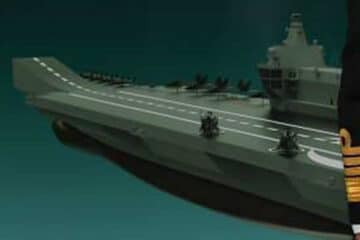Dr Lee Willett reports onboard USS Gerald R. Ford, Portsmouth, UK
New design approaches including installing three aircraft elevators (rather than the four onboard the predecessor Nimitz-class carriers), moving the ship’s island further aft, and having the refuelling station built into the flight deck, alongside introducing new technology for example with the advanced weapons elevators (AWEs), means aircraft onboard can be re-fuelled, re-loaded, re-located, and re-launched more effectively, Commander Richard Rosenbusch, Ford’s Assistant Air Officer, told an onboard media briefing while the carrier visited Portsmouth, UK during its maiden operational deployment.
Improved sortie rate
“What [all this] does is it increases our sortie generation rate …. That means we can land an aircraft or any number of them and we can launch more per unit time,” said Cdr Rosenbusch. “Picture the aircraft carrier like a revolver: it’s how fast you can reload those rounds in the revolver.”

Explaining the operational impact of the improved flight deck layout, Cdr Rosenbusch said “We can park more aircraft in front of the island, we have more room to taxi the aircraft.”
“What the risk is with less room is locking up the deck,” he continued. “So, if I have nowhere to put an aircraft after it lands, I don’t have a clear landing area to land the next one.”
Aircraft launch and recovery is conducted by the electro-magnetic aircraft launch system (EMALS) catapult and the advanced arresting gear (AAG), respectively.

Flight deck aircraft management is enabled also by the new re-fuelling and electricity station set-up. Onboard Nimitz carriers, hoses are strung across two rows of aircraft parked on the flight deck. “Now we just open up a hatch, and we can attach a hose and refuel them right there,” said Cdr Rosenbusch.
“The aircraft are not trapped and they don’t have to wait for every other aircraft in front of them to move before we get them out of there.”
Commander Richard Rosenbusch, Ford’s Assistant Air Officer
Alongside the extra deck space provided through having one less aircraft elevator, the weapons elevators also add flight deck capacity. “The AWEs are a big game-changer, because we don’t need to take a piece of our flight deck’s real estate and dedicate that to weapons anymore,” said Cdr Rosenbusch. Whereas the weapons staging areas on Nimitz carriers are located on the flight deck, “[Ford-class weapons] staging areas are below the flight deck, and we bring the weapons up on the elevators when we need them,” Cdr Rosenbusch added.

There are 11 AWEs onboard: seven servicing the magazine, and four servicing operations up to the flight deck. Driven by an electro-magnetic propulsion system – which uses Wi-Fi sensors and battery power, and has no hydraulics or cables – the AWEs provide “Some of the best advanced technology that we’ve had given to the aviation ordnance community in some time,” Commander James Fish, Ford’s Weapons Officer, told the briefing.
Cdr Fish highlighted two operational benefits the AWEs deliver over the Nimitz-class ships’ weapons transfer capacity. The AWEs can handle 24,000 lb of ammunition in a run, and run at about 150 ft per minute: this compares to a 10,000 lb rating and 100 ft per minute on Nimitz ships. “So, it’s twice as strong and fifty percent faster. That alone allows for a faster re-arm and faster re-loading capability,” he said.
In extensive use of the elevators during work-up and deployment, Cdr Fish explained, “We learned that we can be a lot faster in our full re-load capability. We can take bulk ammunition very quickly, and that has been a huge game-changer.”
Naval News comments:
Naval News flew aboard Ford while the carrier was off the coast of France, participating to exercise Silent Wolverine. Exercise Silent Wolverine tested the first-in-class aircraft carrier capabilities through integrated high-end naval warfare scenarios alongside participating NATO allies. Exercise participants include Canada, Denmark, Germany, France, the Netherlands, Spain, and the United States. Here is our coverage:






